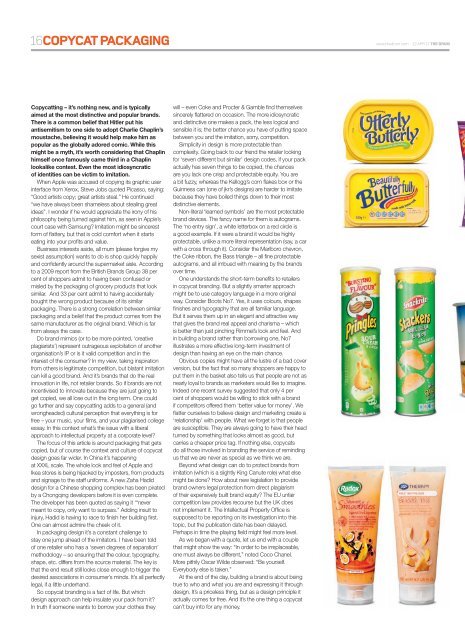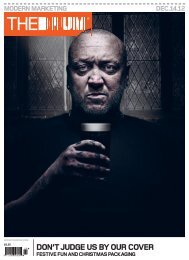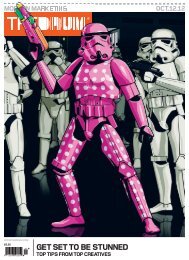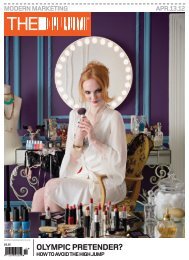REAP WHAT YOU SOW - The Drum
REAP WHAT YOU SOW - The Drum
REAP WHAT YOU SOW - The Drum
Create successful ePaper yourself
Turn your PDF publications into a flip-book with our unique Google optimized e-Paper software.
16COPYCAT PACKAGINGwww.thedrum.com 12.APR.13 THE DRUMCopycatting – it’s nothing new, and is typicallyaimed at the most distinctive and popular brands.<strong>The</strong>re is a common belief that Hitler put hisantisemitism to one side to adopt Charlie Chaplin’smoustache, believing it would help make him aspopular as the globally adored comic. While thismight be a myth, it’s worth considering that Chaplinhimself once famously came third in a Chaplinlookalike contest. Even the most idiosyncraticof identities can be victim to imitation.When Apple was accused of copying its graphic userinterface from Xerox, Steve Jobs quoted Picasso, saying:“Good artists copy; great artists steal.” He continued“we have always been shameless about stealing greatideas”. I wonder if he would appreciate the irony of hisphilosophy being turned against him, as seen in Apple’scourt case with Samsung? Imitation might be sincerestform of fl attery, but that is cold comfort when it startseating into your profi ts and value.Business interests aside, all mum (please forgive mysexist assumption) wants to do is shop quickly happilyand confi dently around the supermarket aisle. Accordingto a 2009 report from the British Brands Group 38 percent of shoppers admit to having been confused ormisled by the packaging of grocery products that looksimilar. And 33 per cent admit to having accidentallybought the wrong product because of its similarpackaging. <strong>The</strong>re is a strong correlation between similarpackaging and a belief that the product comes from thesame manufacturer as the original brand. Which is farfrom always the case.Do brand mimics (or to be more pointed, ‘creativeplagiarists’) represent outrageous exploitation of anotherorganisation’s IP or is it valid competition and in theinterest of the consumer? In my view, taking inspirationfrom others is legitimate competition, but blatant imitationcan kill a good brand. And it’s brands that do the realinnovation in life, not retailer brands. So if brands are notincentivised to innovate because they are just going toget copied, we all lose out in the long term. One couldgo further and say copycatting adds to a general (andwrongheaded) cultural perception that everything is forfree – your music, your fi lms, and your plagiarised collegeessay. In this context what’s the issue with a liberalapproach to intellectual property at a corporate level?<strong>The</strong> focus of this article is around packaging that getscopied, but of course the context and culture of copycatdesign goes far wider. In China it’s happeningat XXXL scale. <strong>The</strong> whole look and feel of Apple andIkea stores is being hijacked by imposters, from productsand signage to the staff uniforms. A new Zaha Hadiddesign for a Chinese shopping complex has been piratedby a Chongqing developers before it is even complete.<strong>The</strong> developer has been quoted as saying it ‘“nevermeant to copy, only want to surpass.” Adding insult toinjury, Hadid is having to race to fi nish her building fi rst.One can almost admire the cheek of it.In packaging design it’s a constant challenge tostay one jump ahead of the imitators. I have been toldof one retailer who has a ‘seven degrees of separation’methodology – so ensuring that the colour, typography,shape, etc. differs from the source material. <strong>The</strong> key isthat the end result still looks close enough to trigger thedesired associations in consumer’s minds. It’s all perfectlylegal, if a little underhand.So copycat branding is a fact of life. But whichdesign approach can help insulate your pack from it?In truth if someone wants to borrow your clothes theywill – even Coke and Procter & Gamble fi nd themselvessincerely fl attered on occasion. <strong>The</strong> more idiosyncraticand distinctive one makes a pack, the less logical andsensible it is; the better chance you have of putting spacebetween you and the imitation, sorry, competition.Simplicity in design is more protectable thancomplexity. Going back to our friend the retailer lookingfor ‘seven different but similar’ design codes, if your packactually has seven things to be copied, the chancesare you lack one crisp and protectable equity. You area bit fuzzy, whereas the Kellogg’s corn fl akes box or theGuinness can (one of jkr’s designs) are harder to imitatebecause they have boiled things down to their mostdistinctive elements.Non-literal ‘learned symbols’ are the most protectablebrand devices. <strong>The</strong> fancy name for them is autograms.<strong>The</strong> ‘no entry sign’, a white letterbox on a red circle isa good example. If it were a brand it would be highlyprotectable, unlike a more literal representation (say, a carwith a cross through it). Consider the Marlboro chevron,the Coke ribbon, the Bass triangle – all fi ne protectableautograms, and all imbued with meaning by the brandsover time.One understands the short-term benefi ts to retailersin copycat branding. But a slightly smarter approachmight be to use category language in a more originalway. Consider Boots No7. Yes, it uses colours, shapesfi nishes and typography that are all familiar language.But it serves them up in an elegant and attractive waythat gives the brand real appeal and charisma – whichis better than just pinching Rimmel’s look and feel. Andin building a brand rather than borrowing one, No7illustrates a more effective long-term investment ofdesign than having an eye on the main chance.Obvious copies might have all the lustre of a bad coverversion, but the fact that so many shoppers are happy toput them in the basket also tells us that people are not asnearly loyal to brands as marketers would like to imagine.Indeed one recent survey suggested that only 4 percent of shoppers would be willing to stick with a brandif competitors offered them ‘better value for money’. Wefl atter ourselves to believe design and marketing create a‘relationship’ with people. What we forget is that peopleare susceptible. <strong>The</strong>y are always going to have their headturned by something that looks almost as good, butcarries a cheaper price tag. If nothing else, copycatsdo all those involved in branding the service of remindingus that we are never as special as we think we are.Beyond what design can do to protect brands fromimitation (which is a slightly King Canute role) what elsemight be done? How about new legislation to providebrand owners legal protection from direct plagiarismof their expensively built brand equity? <strong>The</strong> EU unfaircompetition law provides recourse but the UK doesnot implement it. <strong>The</strong> Intellectual Property Offi ce issupposed to be reporting on its investigation into thistopic, but the publication date has been delayed.Perhaps in time the playing fi eld might feel more level.As we began with a quote, let us end with a couplethat might show the way: “In order to be irreplaceable,one must always be different,” noted Coco Chanel.More pithily Oscar Wilde observed: “Be yourself.Everybody else is taken.”At the end of the day, building a brand is about beingtrue to who and what you are and expressing it throughdesign. It’s a priceless thing, but as a design principle itactually comes for free. And it’s the one thing a copycatcan’t buy into for any money.









